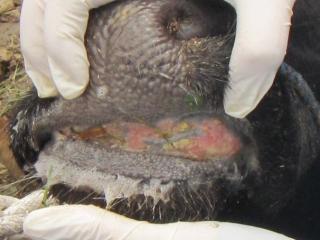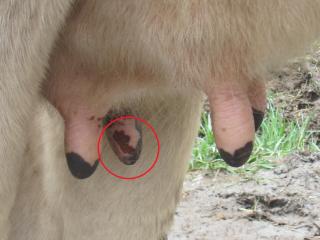| Calling a vet to investigate disease protects our markets The WA Livestock Disease Outlook provides information about recent livestock disease cases in Western Australia and diseases likely to occur in the next month. Calling a vet to investigate diseases when they occur provides surveillance evidence to our markets that we are free of reportable and trade-sensitive diseases. |
Recent livestock disease cases in WA
Sudden deaths in cows grazing kikuyu in late May
- From a mob of 50, nine cows died and 20 were affected within four days of being placed on lush, ungrazed kikuyu pasture.
- Affected animals were drooling, uncoordinated, extending their necks, which progressed to being unable to get up followed by death. One cow had an ulcer on one teat and a small ulcer in the mouth.
- On post-mortem the lungs were heavy and firm and the first stomach was inflamed. Further lab testing showed severe and extensive inflammation of the first and third stomach and ulceration on the tongue. Blood tests also indicated marked dehydration and inflammation.
- The findings were consistent with kikuyu poisoning. There is no specific treatment for kikuyu poisoning, although animals may recover if they are removed from the affected paddock and given supportive veterinary care, provided with good quality hay, water and shelter and not stressed. Some of the cows that were given supportive care survived.
- Exotic rule-out: Given the number of animals sick and showing signs of unwillingness to rise, drooling and teat and mouth ulceration, foot-and-mouth disease and other exotic vesicular diseases were ruled out, supporting WA’s freedom from these diseases.
- Kikuyu poisoning is more common in late summer/early autumn following summer rain that causes the kikuyu to grow rapidly. The toxin that causes disease is not definitively known although the endophyte, Fusarium torulosum, is suspected. Plant stress due to other factors may play a role.
- Read more about kikuyu poisoning in livestock and how to avoid the high-risk periods.
- Read more about how to recognise the signs of the emergency disease, FMD.
Foot-and-mouth disease: signs to look for
Diarrhoea and illthrift in cows in the South-West
- In a mob of 80 cows, three had died and 30 were affected with diarrhoea and illthrift over an extended period. The cows were aged between two and five years, and 70% were in calf.
- A change in diet from silage to pellet mix had not improved the body condition or diarrhoea in sick animals.
- Post-mortem of one sick cow showed thickening of the intestines, as well as enlarged abdominal lymph nodes and watery diarrhoea.
- Lab testing showed chronic inflammation throughout the intestines. There were numerous sections of nematode parasites seen in the fourth stomach despite a negative faecal worm egg count. Worm egg counts may be low or zero in the presence of a worm burden in certain circumstances such as when recent drenching has occurred.
- Copper levels in the sick animal’s liver and in the blood of other animals on the farm were low, which suggested the mob was deficient in this essential trace element and would benefit from supplementation. Johne’s disease in cattle (reportable) was ruled out in this case.
- Naturally occurring copper deficiency is uncommon in WA due to supplementation in fertilisers, however excess dietary molybdenum and zinc can cause a secondary copper deficiency.
- Read more on copper deficiency in sheep and cattle.
In winter, watch for these livestock diseases:
| Disease, typical history and signs |
|---|
| Selenium deficiency in lambs and calves
|
| Listeriosis
|
| Salmonellosis in sheep
|
A warm welcome to returning WA Chief Veterinary Officer
We welcome back Dr Michelle Rodan, who returned to the position of Chief Veterinary Officer of Western Australia on 5 June 2018. For the past two years, Dr Rodan has been leading the Biosecurity and Animal Welfare branch of the Northern Territory Department of Primary Industries and Resources.
Questions about NLIS, brands, property identification codes or stock identification?
DPIRD has a new phone number that will provide a one-stop shop for all of your NLIS, brands and stock ID enquiries. If you have a stock ID question, phone 1300 WA NLIS (1300 926 547).
To find contacts for your nearest DPIRD vet and other Livestock Biosecurity program staff, see the Livestock Biosecurity contacts webpage at agric.wa.gov.au.


